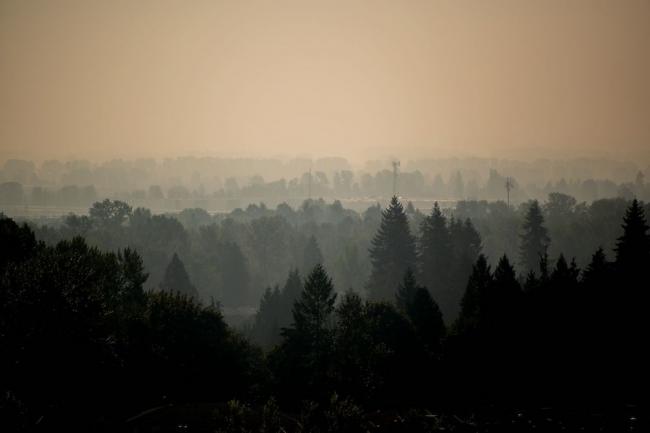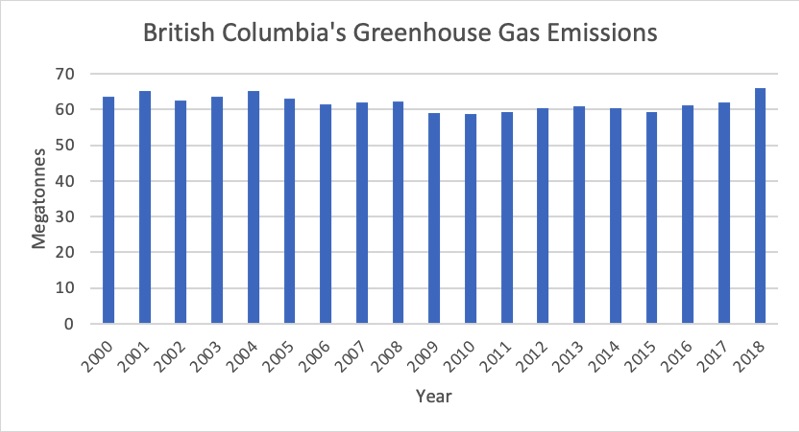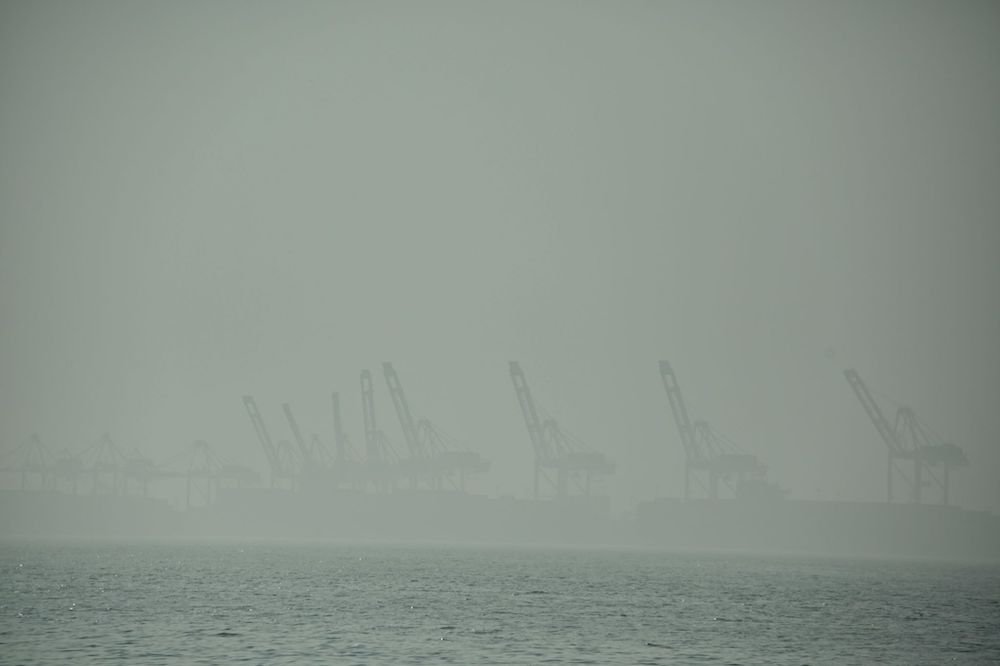Articles Menu

All of us who heed the warnings of climate scientists are increasingly alarmed as we stare at the harrowing gap between what the science says is necessary and what our politics seems prepared to entertain. Despite decades of calls to action, our greenhouse gas emissions are not on a path to stave off a horrific future for our children and future generations.

Let this deeply disturbing chart sink in. And then let us all agree — political leaders, civil servants, environmental organizations, academics and policy wonks, labour leaders, socially responsible business leaders — that what we have been doing is simply not working. We have run out the clock with distracting debates about incremental changes.
But where it matters most — actual GHG emissions — we have accomplished precious little and have frequently slipped backwards. The most recent GHG data is from 2018, and B.C.’s new CleanBC climate plan was only introduced late that year, so it may yet show some progress. But our track record leaves much to be desired.
Ultimately, the planet does not care if our emissions are relatively lower than might have occurred under status quo conditions.
At least things have more or less flatlined, you might say; our emissions are no longer rising. But as the great climate change warrior and founder of 350.org Bill McKibben has said, “Winning slowly on climate change is just another way of losing.”
Politics, as the saying goes, might be all about compromise and the art of the possible. But there is no bargaining with the laws of nature, and nature is now telling us something fierce, with this smoke-filled week just the latest example of “attacks on our soil.” It’s time to dramatically bend the curve.
And so, a new approach is needed. We need a “wartime” mindset and political/policy agenda to tackle the climate emergency.
As we’ve all experienced in this pandemic, emergency responses need to look, sound and feel like emergencies. And they need to align with what the science says we must do. I have spent the last year and a half writing a book about Canada’s Second World War experience, searching for lessons for how to confront the climate crisis and quickly transition off fossil fuels. (A Good War: Mobilizing Canada for the Climate Emergency, ECW Press.) Based on that, here are some signs one would expect to see when a government shifts to a wartime footing:
1. Adopt an emergency mindset. As we’ve witnessed in recent months, something powerful happens when we approach a crisis by naming the emergency and the need for wartime-scale action. It creates a new sense of shared purpose and liberates a level of political and economic action that seemed previously impossible.
2. Shift from voluntary measures to mandatory policies. Why have we made so little progress on lowering our GHG emissions? Because our governments have mainly sought to encourage and incentivize change, employing price signals and rebates, etc. But that’s not what one does in an emergency. In an emergency we require certain actions, using clear timelines and regulatory fiat. Notably, the City of Vancouver, which has a much more ambitious climate plan than the province, is requiring that all new buildings cease using natural gas or any other fossil fuel for space and water heating by 2021, more than a decade sooner than the province. That date should be provincewide. The province has said all new vehicles will need to be zero-emission by 2040. That should be 2025.
3. Rally the public at every turn. It takes leadership to mobilize the public. In frequency and tone, in words and in action, our government needs to communicate a sense of urgency as we mobilize to confront this emergency. Health Minister Adrian Dix and Dr. Bonnie Henry have shown us what that looks like with respect to the pandemic, but this stands in stark contrast to the lackadaisical communications on climate. If our governments are not behaving as if the situation is an emergency — or they send contradictory messages by approving new fossil fuel infrastructure like LNG — then they are effectively communicating to the public that it is not. And why not ban the advertising of fossil fuel vehicles and gas stations, just as we do tobacco products? Their continued presence also sends a confusing message.
4. Create the economic institutions needed to get the job done. During the Second World War, starting from a base of virtually nothing, the Canadian economy and its labour force pumped out planes, military vehicles, ships and armaments at a speed and scale that is simply mind-blowing, much of which occurred right here in B.C. (We produced about 350 ships in the space of six years.) Remarkably, the Canadian government established 28 Crown corporations to meet the supply and munitions requirements of the war effort. The climate emergency demands a similar approach. We must conduct an inventory, determining how many heat pumps, solar arrays, wind farms, electric buses, etc. we will need to electrify virtually everything and end our reliance on fossil fuels. And we will need a new generation of Crown corporations to then ensure those items are manufactured and deployed at the requisite scale. So far, however, in response to the climate emergency, we have created no new crown enterprises.
5. Spend what it takes to win. A benefit of an emergency mentality is that it forces governments out of an austerity mindset and liberates the public purse. That is what we have all witnessed in response to the COVID-19 emergency. But with respect to the climate emergency… not yet. In order to finance the war effort in the Second World War, governments issued new public victory bonds and new forms of progressive taxation were instituted. As we confront the climate emergency, financing the transformation before us requires that we employ similar tools. And when we undertake public investments at the scale the climate crisis demands, we can and will put to rest the employment anxieties of those whose economic security is currently tied to the fossil fuel sector — there will be too much work to do.
6. Stop trying to appease those who seek to block necessary action. The B.C. government’s current Climate Solutions Advisory Council includes a representative from Shell Canada. Previous iterations of this council have included other reps from major fossil fuel corporations. The government is keen to have a climate plan these companies will endorse. But the hour is much too late to be seeking such approval. If our governmental climate plans aren’t making the members of the Canadian Association of Petroleum Producers deeply anxious, then they aren’t climate plans worth having.

A year and a half into the term of B.C.’s NDP government, in December 2018, the province released its new climate plan — CleanBC. The plan contains many welcome elements, and it is a great improvement over what the province had seen to that point. The plan was endorsed by the BC Green Party and praised by key B.C. environmental groups. Core elements include:
CleanBC is, quite likely, the most aggressive and comprehensive provincial or federal climate plan in Canada. And yet, sadly, it does not constitute a real climate emergency plan.
The B.C. government’s targets are not aligned with what the latest report of the UN’s Intergovernmental Panel on Climate Change says we must do. B.C.’s legislated targets are to reduce GHG emissions by 40 per cent by 2030 (from 2007 levels), and by 80 per cent by 2050. The IPCC now says we need to hit at least 50 per cent by 2030 and be carbon-zero by 2050.
The difference between a 2050 target of carbon-zero versus reducing GHGs by 80 per cent may feel largely academic, given the extended time frame. But the difference matters greatly. The problem with a target of 80 per cent reductions by 2050 is that so many of us — both individuals and businesses — falsely presume that what we do or plan to do can be made to fit in the remaining 20 per cent of emissions room. A carbon-zero target disabuses us of this notion.
The current B.C. plan only purports to lay out steps to get three-quarters of the way to the province’s 2030 GHG reduction target (although operationalizing and funding many of these measures remains to be seen). The government had committed to outline how to close the remaining 25 per cent gap by December. Two weeks into this election, that updated plan has yet to arrive.
The lofty commitments of CleanBC are not yet reflected in the B.C. budget, where one must always see if fine words are backed up with real dollars. When the government tabled its February 2019 three-year budget plan (the first since CleanBC was introduced), Canadian Centre for Policy Alternatives senior economist Marc Lee, a long-time analyst of B.C. climate and fiscal policies, calculated the plan would see the province spend only about 0.1 per cent of provincial GDP on climate-related expenditures. Climate investments are similarly lacking from the COVID-19 recovery plan, where the climate transition gets only passing reference.
The framing of the plan is very positive — CleanBC! It rightly says our future can look nice, with plentiful employment opportunities as we tackle climate change. The plan does not, however, communicate that we face a climate emergency. Indeed, CleanBC never once uses the terms “climate emergency” or “climate crisis” or “climate breakdown.”
Most significantly, B.C.’s climate plan is fundamentally at odds with the province’s LNG plans. Earlier in the same year that the plan was unveiled, the provincial and federal governments celebrated the final investment decision of LNG Canada, an international consortium led by PetroChina and Shell that is building a massive new LNG plant in Kitimat. “The largest private sector investment in Canadian history,” both governments repeated ad nauseam.
The problem is that the project represents another huge “carbon bomb” — a massive new source of domestic GHG emissions. Just phase one of the LNG Canada project, along with its “upstream” impacts from extracting and transporting fracked gas, will add between four and six megatonnes of GHGs to B.C.’s annual emissions. All this when the government has committed to reduce total provincial GHGs to 12 megatonnes by 2050. These folks aren’t making their job any easier.
Given the climate crisis before us, the ambition of the current B.C. climate plan is simply not where we need it to be. Even putting aside the reluctance to speak some hard truths on the future of fossil fuels, nothing is stopping the government from substantially staffing up its climate action team (BC’s Climate Action Secretariat within the Ministry of Environment has about 75 staff), from undertaking much higher levels of climate infrastructure investment and, vitally, from using the regulatory power of the state to drive faster change.
The net impact on job numbers would undoubtedly be positive. Yet the government has not taken those steps. The current plan — which, again, represents the most determined climate program in Canada to date — is painfully slow. It does not reflect or communicate a sense of urgency.
There are climate champions in the current government, along with the two Green MLAs. Now is the time for them all to flex their muscles. And we need all of our leaders to reflect on the leaders who saw us through the Second World War and to consider who they want to be, and how they wish to be remembered, as we undertake this defining task of our lives.
If our current leaders believe we face a climate emergency, then they need to act and speak like it’s a damn emergency. We need them to name it, speak continually about it, and rally us at every turn. Because that’s what you do in a crisis. ![]()
[Top photo: Wildfire smoke reached Coquitlam, BC last month. Intensifying wildfires are just one indication that we, like the rest of the planet, aren’t doing enough to stop climate change. Photo by Joshua Berson.]